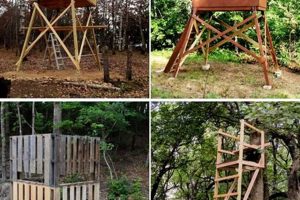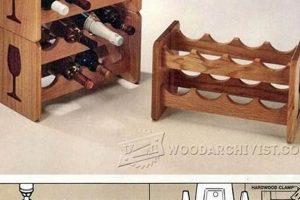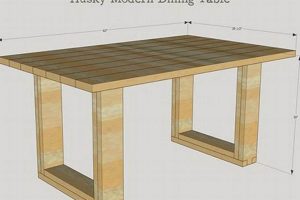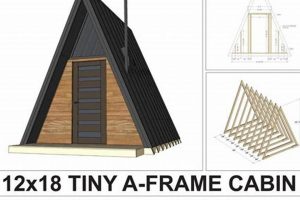A shop-constructed apparatus designed to uniformly reduce the thickness of wood stock represents an exercise in resourcefulness and precision woodworking. These devices, often employing readily available components such as routers, motors, and linear bearings, achieve results similar to commercially manufactured planers. The home-built nature allows for customization to specific workshop needs and budget constraints.
The motivation behind constructing such a tool stems from potential cost savings and the challenge of crafting a functional machine. This approach can be particularly advantageous for woodworkers with specific requirements, such as handling oversized or unusually shaped lumber that standard planers cannot accommodate. Historically, woodworkers have always adapted tools to their specific needs, and this represents a modern iteration of that tradition, leveraging contemporary technology and materials.
Subsequent discussions will delve into the various design methodologies, component selection criteria, and safety considerations pertinent to the successful construction and operation of a wood thicknessing apparatus built in a home workshop environment.
Considerations for a Shop-Fabricated Thicknessing Device
Adherence to sound engineering principles and rigorous safety protocols are paramount during the construction and operation of any shop-fabricated thicknessing device. The following tips outline critical areas demanding careful attention.
Tip 1: Structural Rigidity: The framework supporting the cutting mechanism must possess substantial rigidity to prevent deflection under load. Insufficient rigidity will result in inconsistent thickness and potential machine instability.
Tip 2: Precise Linear Motion: The system facilitating vertical movement of the router or cutter head requires smooth, accurate linear motion. Linear bearings or precisely machined guides are crucial for achieving a consistent cutting plane.
Tip 3: Cutter Head Security: The method of securing the router or cutter head must be robust and reliable. Failure to adequately secure the cutter head poses a significant safety risk.
Tip 4: Dust Collection Integration: Effective dust collection is essential for maintaining a safe and healthy work environment. Design the system to efficiently remove wood chips and dust generated during the planing process.
Tip 5: Gradual Material Removal: Employ incremental depth adjustments to avoid overloading the motor and cutter. Multiple shallow passes are preferable to a single aggressive cut.
Tip 6: Material Feed Control: Implement a controlled and consistent feed rate. Erratic feed rates can lead to tear-out and inconsistent thickness. A mechanical feed system is recommended for optimal control.
Tip 7: Safety Interlocks: Integrate safety interlocks to prevent accidental activation during maintenance or adjustment. These interlocks should disable power to the motor when critical components are exposed or adjusted.
Diligent application of these considerations will improve the safety, accuracy, and longevity of a shop-fabricated wood thicknessing apparatus.
Further exploration of specific design configurations and advanced features will be addressed in the subsequent sections.
1. Structural Integrity
The structural integrity of a shop-constructed wood thicknessing apparatus dictates its performance and safety. It refers to the ability of the device to withstand applied forces without deformation or failure. In the context of a thicknessing apparatus, these forces include the cutting forces generated by the rotating cutter head, the weight of the lumber being planed, and the forces imposed by the feed mechanism. Insufficient structural rigidity leads to several detrimental effects. For example, frame deflection under load results in inconsistent material removal, rendering the apparatus incapable of producing uniformly thick stock. Furthermore, excessive vibration, stemming from a lack of rigidity, contributes to poor surface finish and accelerated wear on components.
Consider a device constructed with inadequate bracing or using materials of insufficient thickness. During operation, the frame may flex, causing the cutter head to deviate from its intended path. This deviation manifests as variations in thickness across the workpiece. Conversely, a properly engineered frame, often employing reinforced steel or thick-sectioned hardwood, resists these forces, maintaining the cutter head’s alignment and enabling consistent planing. A real-world instance involves devices employing unsupported router tables. The inherent flexibility of these tables often compromises accuracy, necessitating substantial reinforcement to achieve acceptable results.
The practical significance of structural integrity lies in its direct correlation to accuracy, safety, and longevity. A robustly constructed apparatus delivers consistent results, reduces the risk of catastrophic failure, and withstands the rigors of repeated use. Therefore, prioritizing structural integrity during the design and construction phases is not merely a matter of aesthetics; it is a fundamental requirement for a functional and safe wood thicknessing device. Compromising on this aspect inevitably leads to diminished performance and heightened risk of injury.
2. Accurate Linear Motion
Accurate linear motion is a critical determinant of performance in a shop-constructed wood thicknessing apparatus. It defines the precision with which the cutting mechanism (typically a router or cutter head) traverses vertically to control the depth of cut. Any deviation from true linear motion introduces inaccuracies, leading to inconsistent material removal and compromised workpiece quality.
- Role of Linear Bearings
Linear bearings are commonly employed to guide the vertical movement of the cutter head platform. These bearings, designed to minimize friction and play, ensure that the cutter head moves precisely along a vertical axis. The choice of bearing type, such as ball bearings or sleeve bearings, directly impacts the smoothness and accuracy of the motion. Inadequate bearings introduce wobble or binding, resulting in uneven planing.
- Importance of Guide Rails
The guide rails upon which the linear bearings travel must be perfectly parallel and rigidly mounted. Any misalignment in the guide rails translates directly into non-linear motion, causing the cutter head to deviate from its intended path. Precision-machined guide rails, often made from hardened steel, are essential for maintaining accuracy over the full range of vertical travel. The absence of properly aligned guide rails represents a critical failure point in a homemade planing device.
- Impact of Lead Screw Systems
In designs incorporating a lead screw for vertical adjustment, the precision and backlash of the screw thread are paramount. Excessive backlash introduces play into the system, making precise depth adjustments difficult and leading to inconsistencies in thickness. High-quality lead screws, paired with anti-backlash nuts, minimize this play and allow for fine-grained control over the depth of cut. Substituting a precision lead screw with a standard threaded rod results in a substantial degradation of planing accuracy.
- Influence of Frame Rigidity
While not directly part of the linear motion system, the frame’s rigidity plays a critical supporting role. A flexible frame allows the guide rails and bearings to deflect under load, compromising the accuracy of the linear motion. A robust frame, capable of resisting deformation, provides a stable platform for the linear motion system to operate effectively. Reinforcement and bracing are often necessary to achieve the required level of rigidity, particularly in larger or more complex designs.
The successful implementation of a thicknessing apparatus hinges on the careful selection and integration of components that facilitate accurate linear motion. Compromising on any aspect of this system, from the quality of the bearings to the rigidity of the frame, inevitably undermines the device’s ability to produce consistently thick and accurately planed lumber. The pursuit of accurate linear motion is, therefore, a central objective in the construction of a functional shop-built planing tool.
3. Cutter Head Security
Cutter head security constitutes a paramount safety and performance consideration in the context of shop-fabricated wood thicknessing apparatus. The rotating cutter head, whether a router or a dedicated planing head, possesses significant kinetic energy, and its secure mounting is essential to prevent catastrophic failure and potential injury.
- Mounting Plate Integrity
The mounting plate, which serves as the interface between the cutter head and the supporting structure, must exhibit exceptional strength and rigidity. The material selection, typically steel or thick aluminum, and the fastening method, such as robust bolts or welds, are critical. A compromised mounting plate may fracture under the stress of operation, releasing the cutter head and creating a projectile hazard. A commercially manufactured router plate may not be suitable without reinforcement due to the increased demands of thicknessing operations.
- Fastener Selection and Torque
The fasteners employed to secure the cutter head to the mounting plate must be appropriately sized and torqued. Undersized fasteners or insufficient torque may allow the cutter head to loosen during operation, leading to vibration and eventual detachment. Conversely, overtightening fasteners can strip threads or damage the mounting plate, compromising its integrity. Calibrated torque wrenches should be employed to ensure proper fastener tension. Periodic inspection and retorquing are advisable to maintain cutter head security.
- Spindle Lock Mechanisms
Many routers and cutter heads incorporate spindle lock mechanisms designed to facilitate bit changes. The engagement of these mechanisms during operation must be strictly prohibited. Accidental activation of the spindle lock while the motor is running can result in immediate and violent failure of the cutter head. Safety interlocks, which prevent motor activation when the spindle lock is engaged, represent a valuable safeguard against this type of incident. Vigilance and adherence to proper operating procedures remain essential.
- Vibration Dampening
Excessive vibration contributes to fastener fatigue and potential loosening of the cutter head. Incorporating vibration-dampening materials, such as rubber bushings or specialized washers, between the cutter head and the mounting plate can mitigate these effects. Furthermore, dynamically balancing the cutter head and motor assembly minimizes vibration at its source. A smoother running apparatus not only improves safety but also enhances the quality of the finished surface.
The aforementioned considerations underscore the criticality of robust cutter head security in shop-fabricated wood thicknessing devices. Addressing these concerns with meticulous attention to detail ensures a safer operating environment and contributes to the overall reliability and longevity of the apparatus.
4. Effective Dust Collection
Effective dust collection is a fundamental requirement for any wood thicknessing apparatus, but its importance is amplified in shop-fabricated designs. Unlike commercially manufactured planers, which often incorporate integrated dust collection systems, these implementations necessitate careful consideration and design to manage the significant volume of particulate matter generated during operation. The health and safety of the operator, the performance of the device, and the overall cleanliness of the workshop depend on the efficacy of the dust collection system.
- Health and Safety Implications
Wood dust poses a well-documented health hazard, ranging from respiratory irritation to more severe conditions such as occupational asthma and certain cancers. Thicknessing operations, due to the aggressive material removal rates, produce substantial amounts of fine dust. A properly designed dust collection system captures this dust at the source, preventing inhalation and minimizing exposure. Without effective dust collection, the operator is subject to prolonged and elevated levels of particulate matter in the air, increasing the risk of adverse health effects. Instances of inadequate dust collection demonstrate the critical need for proper safety measures to protect woodworkers from harmful dust exposure.
- Impact on Machine Performance
The accumulation of wood chips and dust within the working mechanisms of the thicknessing apparatus can impede its performance. Dust buildup on guide rails and bearings increases friction, leading to jerky motion and reduced accuracy. Furthermore, dust accumulation within the motor housing can overheat components, shortening the motor’s lifespan. A well-designed dust collection system removes this debris, maintaining the smooth operation and extending the longevity of the device. Designs lacking adequate dust extraction frequently exhibit reduced accuracy and operational lifespan due to the abrasive nature of wood dust.
- Components of an Effective System
An effective system typically comprises several key components: a shroud or hood positioned close to the cutter head to capture dust at the source, ductwork to transport the dust to a collection device, and a dust collector or shop vacuum to separate the particulate matter from the air. The diameter and length of the ductwork must be carefully considered to minimize airflow restriction. The dust collector should possess sufficient airflow capacity (measured in cubic feet per minute or CFM) and filtration efficiency (measured in microns) to effectively capture fine dust particles. DIY dust collection systems often utilize repurposed components like plastic barrels for chip separation coupled with high-efficiency particulate air (HEPA) filters to maximize fine dust capture.
- Cyclone Separators and Two-Stage Systems
For high-volume thicknessing operations, a cyclone separator is often incorporated into the dust collection system. This device utilizes centrifugal force to separate heavier wood chips from the airflow before they reach the dust collector’s filter. This reduces the load on the filter, extending its lifespan and maintaining optimal airflow. Two-stage systems, consisting of a cyclone separator and a dust collector with a fine filter, provide the most effective dust collection performance, particularly for capturing the fine dust generated by power planing operations. Many woodworkers find that implementing a cyclone separator significantly reduces the frequency of filter cleaning and enhances the overall efficiency of their dust collection.
The implementation of an effective dust collection system is not merely an optional accessory but rather an integral aspect of constructing and operating a shop-fabricated wood thicknessing apparatus. Prioritizing dust collection safeguards the health of the operator, enhances the performance of the device, and maintains a cleaner and safer workshop environment.
5. Gradual material removal
Gradual material removal is a crucial operational strategy for shop-constructed wood thicknessing apparatus, influencing surface quality, tool longevity, and user safety. This approach, which advocates for multiple shallow cuts as opposed to single aggressive passes, becomes especially relevant given the variability inherent in these DIY devices.
- Surface Finish Quality
Shallower cuts minimize tear-out, a defect where wood fibers are lifted and torn by the cutting edge, resulting in a rough surface. In contrast, deeper cuts place greater stress on the wood fibers, increasing the likelihood of tear-out, particularly in woods with complex grain patterns. Devices with less-than-optimal rigidity benefit particularly from lighter cuts, as this reduces the load on the frame and cutter head, further minimizing vibration and improving surface finish. The difference in surface quality between a single deep cut and several shallow cuts is often readily apparent, especially on hardwoods prone to tear-out.
- Motor and Cutter Head Longevity
Removing smaller amounts of material per pass reduces the load on the motor and cutter head. This decreased load translates to lower operating temperatures and reduced wear on bearings and cutting edges. Overloading the motor, especially in devices using repurposed routers, can lead to premature failure. Similarly, excessive force on the cutter head can dull the cutting edges more rapidly. Gradual material removal, therefore, extends the lifespan of critical components, reducing maintenance requirements and overall operating costs. Devices pushed beyond their designed limits by aggressive cutting depths commonly experience accelerated wear and frequent component failures.
- Safety Considerations
Attempting to remove too much material in a single pass increases the risk of kickback, a dangerous event where the workpiece is forcefully ejected from the apparatus. Kickback poses a significant safety hazard, potentially causing injury to the operator. Gradual material removal reduces the cutting forces, decreasing the likelihood of kickback. Furthermore, lighter cuts are less prone to stalling the motor, which can also lead to dangerous situations. Operators employing conservative cutting depths experience a significantly reduced risk of kickback incidents.
- Achieving Accurate Thickness
Multiple shallow passes allow for more precise adjustments in thickness. This is particularly important in shop-fabricated devices, where achieving micron-level accuracy may be challenging. Making smaller adjustments with each pass allows the operator to incrementally approach the desired thickness, minimizing the risk of overshooting the target. This iterative approach also allows for corrections if the device exhibits any inherent inaccuracies. Woodworkers often find that multiple light passes lead to more consistent and accurate final dimensions compared to attempting to achieve the target thickness in a single cut.
The practice of gradual material removal enhances the functionality and safety of these devices. It also mitigates the inherent limitations of shop-fabricated tools, ensuring both improved surface finish and prolonged tool life. The benefits realized from this approach underscore the need for a measured and controlled process.
6. Controlled material feed
Controlled material feed is an essential factor governing the performance and safety of any shop-built wood thicknessing apparatus. Consistent and deliberate movement of the workpiece through the cutting mechanism directly impacts the uniformity of the planed surface, the risk of machine damage, and the potential for operator injury. The implementation of a reliable feed system is, therefore, a critical design consideration.
- Uniform Thickness and Surface Quality
Erratic or inconsistent feed rates result in uneven material removal, manifesting as variations in thickness across the workpiece. Slowing or pausing the feed allows the cutter head to dwell in a single location, creating dips or gouges. Conversely, accelerating the feed rate reduces the material removed per pass, potentially leading to an unacceptably rough surface. A controlled feed system, whether manual or mechanical, ensures a constant rate of material removal, yielding a uniformly thick and smooth surface. Examples of well-controlled systems include those employing geared motors and rollers to provide a consistent feeding force.
- Motor and Cutter Head Protection
Uncontrolled feed rates can overload the motor and cutter head. Forcing material through the apparatus too quickly places excessive strain on these components, increasing the risk of stalling the motor or damaging the cutter head. Conversely, excessively slow feed rates, particularly in conjunction with aggressive depth settings, can cause the motor to overheat. A controlled feed system optimizes the load on the motor and cutter head, preventing overstress and extending their operational lifespan. Real-world applications often show that systems with adjustable feed rates allow for matching the feed speed to the wood hardness and depth of cut to prevent motor strain.
- Safety and Kickback Prevention
Sudden or uncontrolled acceleration of the workpiece can lead to kickback, a dangerous phenomenon where the workpiece is forcefully ejected from the apparatus. Kickback poses a significant safety hazard, potentially causing serious injury to the operator. A controlled feed system, particularly one incorporating anti-kickback features such as one-way rollers, minimizes the risk of kickback by maintaining a consistent and predictable feeding force. Numerous incidents highlight the importance of features preventing material from unexpectedly reversing direction.
- Manual vs. Mechanical Feed Systems
While manual feed systems, where the operator pushes the workpiece through the apparatus, can be employed, they are inherently less consistent than mechanical systems. Mechanical systems, utilizing rollers or belts driven by a motor, provide a more uniform and controllable feed rate. Manual feed systems are susceptible to variations in operator force and fatigue, while mechanical systems offer a consistent and repeatable performance. In applications requiring high precision or involving large workpieces, mechanical feed systems are generally preferred. Many builders opt for adding a motorized feed to a manual system to improve overall control and reduce the physical strain of planing longer boards.
In summary, consistent material delivery through the DIY thickness planer is achievable through a structured method, directly influencing output quality, equipment preservation, and operator protection. This is typically achieved through a system where the operator, or a motor, provides steady pressure.
7. Safety interlocks
The integration of safety interlocks within a shop-constructed wood thicknessing apparatus represents a crucial measure for mitigating potential hazards. These mechanisms, designed to interrupt power to the motor under specific conditions, prevent inadvertent operation during maintenance, adjustment, or in the event of a component failure. Without such safeguards, the risk of accidental activation and subsequent injury escalates significantly. A prevalent example involves interlocks that disable the motor when the cutter head guard is removed or when access panels are open, preventing exposure to the rotating blades. Failure to implement such interlocks has resulted in severe injuries during bit changes or machine cleaning.
Safety interlocks also address scenarios involving component malfunctions. Consider a system where a limit switch detects the over-extension of the vertical adjustment mechanism. If the mechanism exceeds its designated travel limit, the interlock immediately cuts power to the motor, preventing further movement and potential damage to the machine or injury to the operator. This proactive approach reduces the likelihood of catastrophic failures and ensures a safer operating environment. Further applications involve sensors that detect abnormal vibration or overheating, triggering a shutdown to avert potential accidents.
The implementation of effective safety interlocks necessitates a thorough understanding of the apparatus’s operation and potential failure modes. While these mechanisms add complexity to the design, they represent a fundamental investment in operator safety. Their absence constitutes a significant design flaw, increasing the risk of accidents and underscoring the importance of prioritizing safety in the construction of shop-built woodworking machinery.
Frequently Asked Questions
The following questions address common inquiries and misconceptions regarding the design, construction, and operation of wood thicknessing apparatus fabricated in a home workshop environment.
Question 1: Is a shop-fabricated thicknessing apparatus a viable alternative to a commercially manufactured planer?
Viability depends on the builder’s skill, available resources, and intended use. Commercial planers offer proven performance and safety features. A shop-fabricated apparatus necessitates careful design and construction to achieve comparable results.
Question 2: What are the primary safety concerns associated with such devices?
The rotating cutter head represents the foremost hazard. Robust cutter head security, effective guarding, and safety interlocks are essential to mitigate the risk of injury.
Question 3: What type of motor is suitable for a shop-fabricated thicknessing apparatus?
A motor with sufficient power and speed to effectively remove material without stalling or overheating is required. Router motors or dedicated spindle motors are commonly employed. Precise motor selection is crucial.
Question 4: How is accurate thickness adjustment achieved?
Precise linear motion, often facilitated by linear bearings and lead screws, is essential. Incremental depth adjustments and calibrated scales enable accurate thickness control.
Question 5: Is dust collection necessary?
Effective dust collection is paramount for operator health and machine longevity. A well-designed system captures airborne particulate matter, preventing respiratory irritation and maintaining a clean work environment.
Question 6: What materials are appropriate for constructing the frame?
The frame must exhibit sufficient rigidity to prevent deflection under load. Steel, reinforced hardwood, or a combination thereof are suitable choices. Structural integrity is paramount.
These FAQs highlight critical considerations for individuals contemplating the construction of a shop-fabricated wood thicknessing apparatus. Diligence in addressing these concerns enhances both the performance and safety of the device.
The subsequent section will discuss potential modifications and enhancements to existing designs.
Conclusion
The construction of a diy thickness planer presents a unique challenge, demanding a comprehensive understanding of woodworking principles, mechanical engineering, and safety protocols. Successful implementation hinges upon prioritizing structural integrity, accurate linear motion, cutter head security, effective dust collection, gradual material removal, controlled material feed, and comprehensive safety interlocks. Compromising on any of these aspects can lead to diminished performance, accelerated wear, and heightened risk of injury.
While commercially manufactured planers offer established reliability and safety features, the pursuit of a shop-fabricated alternative can provide cost savings and the opportunity for customization. However, prospective builders must meticulously assess their capabilities and resources before embarking on such a project. A well-executed diy thickness planer can prove to be a valuable addition to a woodworking shop, but its success hinges on informed design, diligent construction, and unwavering adherence to safe operating practices.







